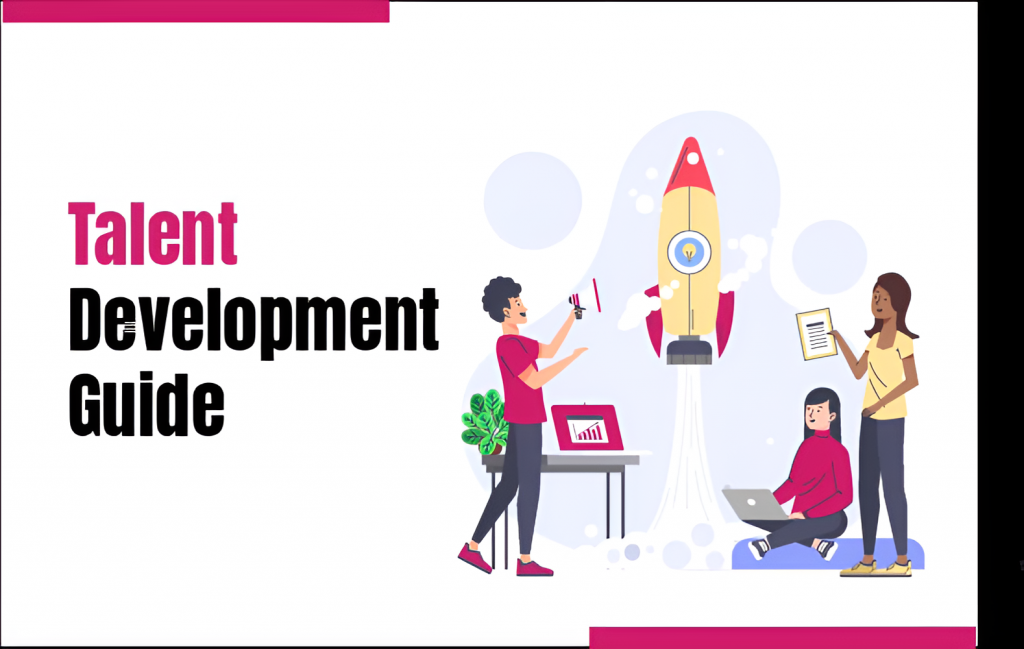Unlocking Employee Potential: Essential Guide to Talent Development

Every business owner aims to create an office where every employee can excel. Consider Sarah, who excels at problem-solving, and John, a natural leader who inspires others effortlessly. Like many other employees, they possess hidden talents waiting to be discovered. With this Talent Development Guide and strategies for unlocking employee potential, you can maximize your revenue. Additionally, by identifying and nurturing these talents, you can create a more productive and successful workplace environment.
In this article, we’ll look at a Talent Development Guide to help businesses unleash their teams’ full potential. Also, business management will get an idea about what employees want.
What is Talent Development?
Talent development means finding, nurturing, and improving employees’ skills to help them do well in their jobs and help the company. It’s also about seeing their potential and giving them chances to grow, so they can make a bigger difference to the company’s goals. Additionally, it’s about giving them the right chances to learn and develop, so they can have a bigger impact on what the company wants to achieve.
Why is Unlocking Employee Potential so Important in Businesses?
Supporting employees in reaching their full potential is crucial for businesses. When employees feel valued and engaged, they are less inclined to seek other employment opportunities. Research from Gallup indicates that engaged employees demonstrate lower intentions of leaving their current jobs. Therefore, by fostering employee growth and success, businesses can increase employee retention and enhance overall workplace satisfaction.
Tips For Understanding Employee Potential
Understanding employees’ potential is important for getting the best out of them. By following some helpful tips from this Talent Development Guide, you can better understand what your employees can do.
- Regular Assessments: Conduct regular evaluations to assess employees’ skills, strengths, and areas for improvement. This helps understand their current abilities and where they can improve.
- Open Communication: Encourage open communication among employees to discuss career goals, aspirations, and challenges. This builds trust and offers valuable insights into their potential.
- Challenging Assignments: Give employees challenging tasks or projects to expand their skills and discover hidden talents. This helps them grow and learn new things.
- Mentorship Programs: Establish mentorship programs where seasoned employees can mentor and support others in reaching their potential. This aids in skill development and boosts confidence.
- Job Rotation: To nurture employee growth, consider rotating them across different roles or departments. This strategy helps them gain diverse experiences, uncover their potential, and broaden their skill set. Additionally, it fosters adaptability, enhances teamwork, and promotes innovation within your organization.
- Performance Metrics: Establishing clear performance metrics and goals is essential for employees to track their progress and assess their potential. By defining specific targets and measurable objectives, employees gain clarity on what is expected of them and how their performance will be evaluated. This transparency enables them to focus their efforts effectively, stay motivated, and identify areas for improvement.
- Continuous Feedback Loop: Create an environment where feedback and communication happen often. This helps employees feel supported and valued as they grow.
In addition to these methods, skill tests and performance reviews are vital for identifying employees’ strengths. They offer insights into capabilities and areas for improvement. Additionally, they provide data for training, promotions, and job assignments.
Strategies for Talent Development Guide

- At first, it’s important to find out what each employee is good at and where they can do better. This can be done in different ways, like tests, feedback from managers and coworkers, and thinking about their own work.
- To help employees grow, offer different training programs, workshops, and courses. These cover technical skills, like using computers, and softer skills, like talking with others. Also, they include industry-specific knowledge.
- Encourage a culture of always learning. Employees should be motivated to learn new things. This means giving them access to things like online classes, books, and seminars to help them keep growing.
- Furthermore, mentorship is important. It connects employees with experienced mentors who give helpful advice, support, and feedback. In coaching sessions, employees can set goals, overcome challenges, and reach their full potential.
- Provide chances for employees to work on tough projects or tasks that push their abilities. This helps them learn new skills, get important experience, and move forward in their careers.
- Work together with employees to make individual career plans. These plans show their long-term goals and the steps they need to take to achieve them. This might include ways to move up in their job, extra training, and improving skills.
- Regularly give feedback to employees about how they’re doing at work. Highlight what they’re good at and where they can get better. Also, praise them when they do well to encourage them to keep improving.
- Create a supportive workplace where employees feel comfortable taking risks, learning from mistakes, and growing. Encourage teamwork, creativity, and new ideas to help everyone succeed together.
Leveraging Performance Management for Talent Development
- Performance Appraisals and Feedback
Regular performance reviews and 360-degree feedback meetings make it easy to talk and help employees know what they’re good at and where they can improve.
- Setting SMART Goals for Development
Creating SMART goals – Specific, Measurable, Achievable, Relevant, and Time-bound – makes sure everyone knows what they’re working towards and can be responsible for their progress.
The Role of Leadership in Talent Development
- Leadership Development Programs
Investing in leadership training helps managers learn how to support and grow their teams better.
- Empowering Managers as Coaches
Assigning managers the role of coaches enables them to continue assisting and guiding employees, ensuring ongoing development.
Technology in Talent Development
- Learning Management Systems (LMS)
LMS platforms help deliver and manage training programs, making learning easier and more comprehensive. They make it simple to access training and manage it easily. Moreover, LMS platforms offer various features such as tracking progress, generating reports, and facilitating communication between learners and instructors. Besides, they provide flexibility in terms of accessing training materials anytime, anywhere. In conclusion, LMS platforms play a crucial role in enhancing the learning experience and promoting continuous development.
- Digital Training Platforms and Tools
Online courses, webinars, and mobile apps provide employees with flexible and enjoyable learning options.
Measuring Success and ROI
- Key Performance Indicators (KPIs) for Talent Development
Key performance indicators (KPIs) such as how involved employees are, how many stay, and how good their skills are, show how well talent development plans are working for businesses. These metrics are important to assess if talent development efforts are successful. Moreover, tracking these KPIs helps businesses understand their progress and make necessary adjustments to their talent development strategies. Additionally, by monitoring these metrics, businesses can ensure that they are effectively nurturing and retaining their workforce. Ultimately, these KPIs serve as vital benchmarks for measuring the success of talent development initiatives.
- Evaluating the Impact of Talent Development Initiatives
By analyzing the return on investment (ROI) of talent development programs, businesses can make data-driven decisions and allocate resources strategically.
Overcoming Challenges in Talent Development
- Addressing Skill Gaps:- Identifying skill gaps and providing focused training is key to unlocking employee potential. This targeted approach helps employees grow.
- Engaging and Retaining Talent:- Creating a positive work environment, offering attractive benefits, and providing opportunities for career advancement are crucial for retaining top employees. These elements motivate employees to remain committed and perform at their best.
In conclusion, unlocking employee potential is not only beneficial for individual employees but also essential for the long-term success of businesses. By investing in talent development and fostering a culture that values growth and learning, businesses can unleash the full potential of their workforce and drive organizational success. Furthermore, moving forward, the question remains: How will your business seize the opportunity to uncover the hidden talents of your employees?
Fostering a supportive work environment encourages employees to reach their full potential. Additionally, offering ongoing training helps enhance skills. Moreover, acknowledging and rewarding achievements motivates employees to excel. Furthermore, seeking feedback fosters collaboration and innovation. In addition, accepting diversity harnesses varied talents. Plus, promoting work-life balance supports well-being and productivity. Moreover, effective communication ensures clarity and alignment. Lastly, embracing change positions businesses for success.
Our team of experienced professionals specializes in talent development and organizational effectiveness. For inquiries or consultation services, contact us.
By following the strategies outlined in this Talent Development Guide and leveraging the power of talent development, businesses can unlock the full potential of their employees and drive sustainable growth and success.
Recent Posts
- Strategies for Customer Expectations | Adapting to Change
- From Feedback to Action: QaizenX’s Approach to Turning Insights into Results
- Enhancing Customer Loyalty through Personalized Experiences
- Unlocking Leadership Excellence: Strategies to Become a Great Manager
- 4 E’s of Employee Engagement and How To Implement Them



